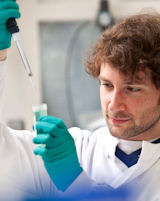You are here: Centre for Doctoral Training in Molecular-Scale Engineering > Our Students > William Morton
William Morton

Prior to the CDT
I graduated with a Master of Physics degree from the University of St Andrews, where, in my final year project, I worked on a method for synthesising ZnO nanoparticles in which the aspect ratios of the particles could be controlled by changing the initial ratios of the reactants. I then undertook an MSc at the University of Leeds in Medical Physics, where I studied the interface between physics and biology from a medical aspect.
Before starting my PhD, I worked at Trinity College, Dublin, looking at forming films of two-dimensional compounds (similar to graphene) from their bulk state using ultrasonic energy.
Attraction to the CDT
I chose to do my PhD in the CDT rather than in the conventional PhD format because I wanted to work across disciplines between physics, biology and chemistry. I thought the CDT presented an ideal opportunity to introduce myself to molecular-scale interdisciplinary research. It has allowed me to combine the physics I know from my degree with aspects of biology I have learned from some of the modules I have undertaken as part of the CDT.
In addition to this, the lab rotations in the first year present a unique opportunity to spend some time working in a group, getting to know the research, the group and the supervisor, before committing yourself to a 3-year PhD.
Research interests
In general, my research interests lie in the crossover between physics and biology. I think the use of biological molecules in designed systems, such as proteins in biosensors or DNA in electronic circuits, is fascinating. There is also such a vast amount of work that has yet to be done in probing biological systems using physical techniques like AFM.
My first lab rotation involved forming a self-assembled monolayer (SAM) of a coiled-coil peptides on a gold surface. The aim of the project was to study how the SAM formation changed with changing buffer pH. I gained a great deal of experience using several different interrogation techniques during this project. The project formed part of a larger study looking at the formation of SAMs of these peptides, which was recently submitted for publication, and on which I am a named author.
My second rotation was in the Faculty of Biological Sciences, where I compared binding affinities of several different proteins for use in biosensors. As my background is in physics, I chose this rotation to improve my knowledge of and experience in biochemical and molecular biological techniques.
I am currently halfway through my third rotation, in which I am using an atomic force microscope (AFM) to stretch a protein in order to better understand its folding/unfolding pathways. This is called force extension spectroscopy, and the protein I am studying is from an extremophile bacteria that is found in underwater volcanoes, but has a mesophillic counterpart found in the human body.
Highlights and challenges
There have been many highlights on the course so far. In particular, the first week (the residential week) was a brilliant time where we got to know the other students on the CDT and the directors, and learned more about the course structure and the projects. I have also thoroughly enjoyed all my lab rotations so far, where there has been a tremendous amount of support from the supervisors and the CDT directors.
The main challenge I have faced so far is working in a biological lab on a molecular biology project. Learning new techniques is always a challenge, but sometimes it seemed like the people in the lab were talking a different language when talking about their research! However, I am very glad I took that project, as I feel much more confident now in working with biological molecules and discussing the biological aspects of my work.


